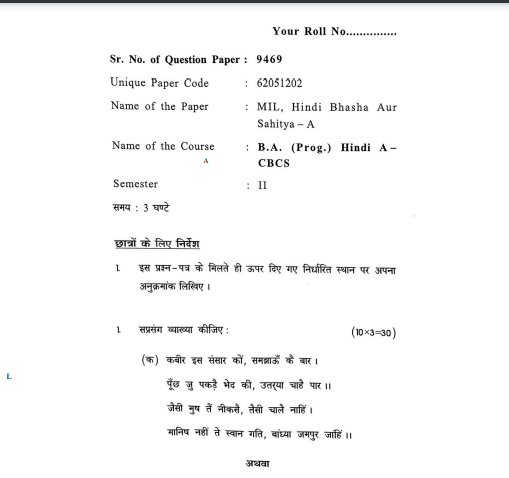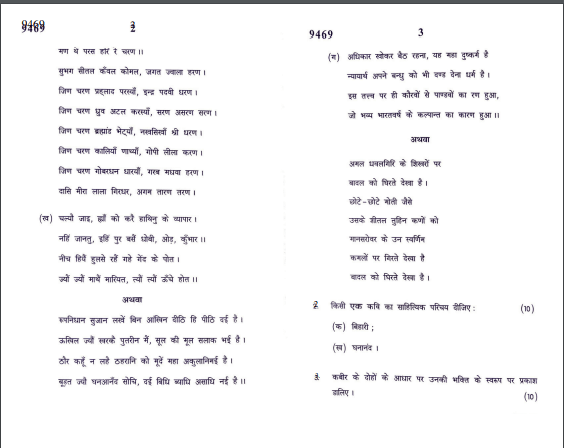BA Hindi Hons Question Papers Du
Welcome to our blog dedicated to the BA Hindi Hons Question Papers Du Whether you are a student preparing for your exams or a professional looking to deepen your understanding of business principles, this blog is designed to provide you with valuable insights and resources.
- Overview : BA Hindi Hons Question Papers Du
- Download : BA Hindi Hons Question Papers Du
- Syllabus : BA Hindi Hons Question Papers Du
- Exam Pattern BA Hindi Hons Question Papers Du
- Significance of BA Hindi Hons Question Papers Du
- Tips for Good Preparation
- FAQs : BA Hindi Hons Question Papers Du
Overview : BA Hindi Hons Question Papers Du
BA 1st Year Hindi question paper can vary depending on the specific university or college syllabus. However, here’s a general overview to give you an idea of what to expect:
Structure:
The paper is likely divided into sections, typically with a total of 100 marks. The number of sections and weightage allocated to each might differ. Here’s a possible breakdown:
Section 1: Language & Grammar (30-40 marks):
Questions testing knowledge of Hindi grammar rules (e.g., sandhi, genders, verb conjugations)
-
- Comprehension passage with questions on vocabulary and understanding
- Error identification and correction
-
Section 2: Literature (30-40 marks):
- Questions based on prescribed texts or poems (poetry analysis, character analysis, themes)
- Essay on a literary topic or given quote
-
Section 3: Writing Skills (20-30 marks):
- Creative writing prompts (story, essay, poem) based on a theme or situation
- Formal writing tasks like letter, report, or application
Tips for Success:
- Know Your Syllabus: Familiarize yourself with the specific books, poems, or topics prescribed in your curriculum.
- Grammar is Key: Revise Hindi grammar rules and practice applying them through exercises.
- Comprehension Practice: Regularly read Hindi passages and answer comprehension questions to improve reading comprehension and vocabulary.
- Practice Writing: Write different types of creative and formal pieces to hone your writing skills and manage time effectively during the exam.
- Analyze Literature: Understand the underlying themes, characters, and literary devices in prescribed texts for insightful answers.
- Develop a Reading Habit: Read not just prescribed texts but also other Hindi literature to broaden your knowledge and vocabulary.
Additional Resources:
- Textbooks and Class Notes
- Previous Year Question Papers (if available)
- Online Resources and Hindi Literature Websites
- Hindi Dictionaries and Grammar Guides
Download : BA Hindi Hons Question Papers Du
| Paper PDF Download | Question Paper with Solution |
|---|---|
| BA Hindi Paper | Download Here |


Syllabus : BA Hindi Hons Question Papers Du
| Aspect | Details |
|---|---|
| Paper Structure | Divided into sections: literature, grammar, and writing. |
| Marking Scheme | Clear allocation of marks for each section, including partial marking for specific question types. |
| Section-wise Weightage | Literature: 40%, Grammar: 30%, Writing: 30%. |
| Question Types | Mix of multiple-choice questions (MCQs), short answer questions, and long answer/essay-type questions. |
| Time Allocation | Total exam duration: 3 hours. Recommended time: Literature – 1 hour, Grammar – 1 hour, Writing – 1 hour. |
| Difficulty Levels | Questions range from basic to advanced, ensuring a comprehensive assessment of students’ knowledge and skills. |
| Use of Examples | Encourages the use of relevant examples and quotes from Hindi literature in answers, especially in the literature and writing sections. |
| Previous Years’ Trends | Includes questions that reflect trends and patterns from previous years to aid in focused preparation. |
| Overall Purpose | Designed to assess students’ understanding of Hindi literature, grammar proficiency, and writing skills comprehensively. |
Exam Pattern of BA Hindi Hons Question Papers Du
| Aspect | Details |
|---|---|
| Paper Structure | Divided into sections: literature, grammar, and writing. |
| Marking Scheme | Clear allocation of marks for each section, including partial marking for specific question types. |
| Section-wise Weightage | Literature: 40%, Grammar: 30%, Writing: 30%. |
| Question Types | Mix of multiple-choice questions (MCQs), short answer questions, and long answer/essay-type questions. |
| Time Allocation | Total exam duration: 3 hours. Recommended time: Literature – 1 hour, Grammar – 1 hour, Writing – 1 hour. |
| Difficulty Levels | Questions range from basic to advanced, ensuring a comprehensive assessment of students’ knowledge and skills. |
| Use of Examples | Encourages the use of relevant examples and quotes from Hindi literature in answers, especially in the literature and writing sections. |
| Previous Years’ Trends | Includes questions that reflect trends and patterns from previous years to aid in focused preparation. |
| Overall Purpose | Designed to assess students’ understanding of Hindi literature, grammar proficiency, and writing skills comprehensively. |
Significance of BA Hindi Hons Question Papers Du
The significance of Paper PDF Download with Solution lies in their ability to serve as valuable study resources for candidates preparing Exam for the Here are some key reasons why these question papers are important:
Exam Blueprint Revealed:
The actual exam is modeled by these papers. You can learn a lot about the arrangement of the questions, the relative importance of the various areas on the syllabus, and even the degree of difficulty by carefully examining them. This enables you to customize your study and give priority to the subjects that need greater attention.
Improving Your Skills:
Using past year papers for practice is similar to taking practice exams in a real exam setting. You get to put your speed, accuracy, and conceptual understanding to the test in a virtual setting. This assists in determining your areas of strength and weakness prior to the exam, enabling you to improve your strategy and reinforce your comprehension of important subjects.
Building Exam Stamina:
The Exam may have a time limit, therefore success depends on your ability to manage your time well. You can improve your endurance and time management abilities for the test by using previous year’s papers. You can learn to pace yourself, prioritize questions, and stay away from becoming bogged down on any one problem by practicing in a timed environment.
Increasing Confidence:
Completing last year’s papers successfully boosts your self-assurance and eases exam anxiety. Observing that you can appropriately respond to questions validates your understanding and inspires you to keep trying. Your overall exam performance is significantly impacted by this positive reinforcement.
Finding Recurring Patterns:
Although the precise questions won’t be asked again, reviewing previous exams frequently identifies patterns in the subjects and question types that are asked again. This enables you to create focused strategies for answering the kinds of questions you might encounter on the actual exam by anticipating their types.
Tips for Good Preparation
Here are some recommendations for adept readiness for the Exam :
Comprehend the Curriculum:
Initiate by thoroughly grasping the Exam syllabus. Segregate it into manageable fragments and devise a study regimen accordingly.
Consult Authoritative Texts:
Utilize authoritative textbooks and scholarly materials endorsed by specialists for each discipline. Ensure comprehensive coverage of all subjects.
Contemporary Affairs:
Stay abreast of contemporary affairs from credible outlets such as newspapers, periodicals, and online platforms. Concentrate on domestic and international occurrences, governmental endeavors, and significant advancements.
Rehearse Previous Year’s Papers:
Resolve preceding years’ examination papers to fathom the examination blueprint, question varieties, and time allocation. It will also aid in pinpointing pivotal subjects.
Simulated Assessments:
Undertake periodic simulated assessments to gauge your preparedness level. Assess your performance, discern strengths and deficiencies, and endeavor to enhance them.
Reiteration:
Routine reiteration holds paramount importance. Frequently revisit essential concepts, formulas, and facts to enhance retention.
Compile Concise Notes:
Formulate succinct notes during study sessions. These annotations will facilitate swift review in the eleventh hour preceding the examination.
Emphasize Conceptual Comprehension:
Instead of rote learning, prioritize grasping concepts. This approach enhances efficacy in addressing application-oriented queries.
Chronological Allocation:
Exercise chronology management while tackling simulated assessments and during authentic preparations. Assign time to each subject/domain contingent on its significance and your adeptness.
Preserve Well-being:
Uphold a wholesome lifestyle by consuming nutritious sustenance, engaging in regular physical activity, and securing sufficient rest. Robust physical and mental well-being is indispensable for effective scholarship.
Sustain Encouragement:
Sustain motivation throughout the preparatory odyssey. Establish feasible objectives, commemorate minor triumphs, and uphold optimism even amid adversarial circumstances.
FAQs : BA Hindi Hons Question Papers Du
Q. What are the main topics covered in the BA 1st Year Hindi syllabus?
A: The BA 1st Year Hindi syllabus typically includes topics such as Hindi literature, grammar, prose, poetry, and essay writing. Students may study various literary forms, important works of Hindi literature, and notable authors. The syllabus often focuses on developing language skills and understanding cultural and historical contexts.
Q. How is the BA 1st Year Hindi exam structured?
A. The BA 1st Year Hindi exam usually consists of multiple sections, including objective questions (like multiple-choice questions), short answer questions, and long answer/essay-type questions. The paper may be divided into sections to assess different areas such as literature, grammar, and writing skills.
Q. What types of questions can I expect in the Hindi literature section?
A. In the Hindi literature section, you can expect questions that require you to analyze and interpret literary texts, discuss themes, characters, and plots, and provide critical evaluations of poems, stories, or essays. There may also be questions about the historical and cultural background of specific literary works and authors.
Q. How can I effectively prepare for the Hindi grammar section of the exam?
A. To effectively prepare for the Hindi grammar section, practice is key. Regularly review grammar rules, practice sentence formation, and complete exercises on topics such as nouns, verbs, tenses, syntax, and punctuation. Using grammar workbooks and online resources can also be helpful for additional practice.